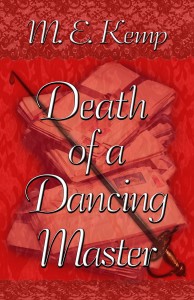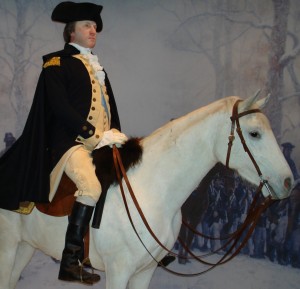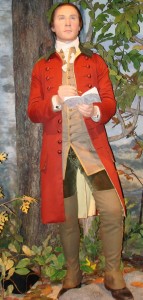 Relevant History welcomes author M. E. Kemp. Kemp was born in Oxford, MA in 1713 — oops, that’s the year her ancestors settled the town. She lives in Saratoga Springs, NY where she touts horses in the racing season and writes historical mysteries on the side. She is married to Jack H. Rothstein, who keeps her “on track,” and lives with two kitties, Boris and Natasha, who act as editors tearing to shred her scripts — literally. For more information, check her web site.
Relevant History welcomes author M. E. Kemp. Kemp was born in Oxford, MA in 1713 — oops, that’s the year her ancestors settled the town. She lives in Saratoga Springs, NY where she touts horses in the racing season and writes historical mysteries on the side. She is married to Jack H. Rothstein, who keeps her “on track,” and lives with two kitties, Boris and Natasha, who act as editors tearing to shred her scripts — literally. For more information, check her web site.
*****
I write historical mysteries with two nosy Puritans as detectives. One of my tasks as a writer is to be historically accurate. Another is to dispel the many myths and false pictures of our colonial ancestors that are prevalent, even in the way the media portrays them today.
Far from the stern-faced skinny old stick-in-the-mud image, the typical Boston Puritan was a proud man strutting around in a scarlet cloak with a forest-green or perhaps a violet coat, embroidered waist coat, small clothes of various shades, and silk stockings with silver-buckled red shoes. And lace, plenty of exquisite lace falling from his collar and dripping from his sleeves. And that’s the men. (Men today could learn a thing or two about elegant dress from the old Puritans!) You can imagine that the women of New England would not be backwards in their attention to dress. From the earliest days women defied clothing restrictions and blossomed out in the latest fashions from Paris and London. Good sea-captain husbands helped out by bring back little dolls called “fashion babies” wearing the new fashions so the goodwives could study and share the dolls with neighbors. Colors ranged from bright to pastels, with scarlet being the favorite. Scarlet was such a bright warming color for a cold winter’s day — thus argued the Reverend Cotton Mather from his pulpit until a wealthy member of the congregation finally gave in and gifted him with such a cloak.
The one portrait I’ve found of a New England Puritan in black was of a handsome merchant dressed in a black velvet suit with a large, delicate lace collar covering his shoulders. (How I’d love to get my hands on lace like that!) His wife wears a sober olive dress — but her petticoat is bright red with gold embroidered trim. Even an old soldier wears an exquisite “fall” of lace at his throat while a battle rages outside his window. Dressed to kill? So much for the dowdy Puritans of myth!
The fine clothing covers a dirty little secret, though. Our ancestors were none too clean. If cleanliness is next to godliness, then our poor ancestors are groaning in H-E-double Hockey Sticks! And that just can’t be.
Oh, not that the Saints were saints; they ate prodigious amounts of food and drank even more prodigious amounts of hard liquor. Just check the tavern bills for a meeting of clergymen! I’ll bet on a Puritan minister over your biggest lush that the Puritan can out-drink the modern lush any day. Anyone who could down one of “Sparke’s Specials” — rum, beer, bread crumbs and molasses — must have a stomach of cast iron.
And as for sex, we forget that the early Puritans were actual Elizabethans, born and raised under that earthy Queen. The Puritans were probably more open about sex than we are today. They didn’t have the hang-ups, that’s for sure. One gentleman, accorded “a lusty big man,” bragged that he coveted the miller’s wife. He “coveted” her four times in one afternoon and was fined for it, no doubt with the secret envy of the magistrates. (I guess he must have been a lusty big man!) And there goes the joyless image of the Puritans.
My roaming rogue of a dancing master in Death of a Dancing Master isn’t so far off the mark! Unfortunately he meets a fatal end. There are plenty of suspects for my two nosy detectives to pursue — jealous husbands and deceiving wives, angry magistrates and sermonizing ministers. Death of a Dancing Master is based on a real incident, as are all my books, but in this case the real dancing master was merely harassed out of Boston. But then I wouldn’t have had a murder mystery to write, would I?
*****
 Thanks to M. E. Kemp for the fun post! She offers to give away a print copy of Death of a Dancing Master to someone who contributes a comment on my blog this week. I’ll choose the winner from among those who comment by Friday at 6 p.m. ET. Delivery is available within the U.S. only.
Thanks to M. E. Kemp for the fun post! She offers to give away a print copy of Death of a Dancing Master to someone who contributes a comment on my blog this week. I’ll choose the winner from among those who comment by Friday at 6 p.m. ET. Delivery is available within the U.S. only.
**********
Did you like what you read? Learn about downloads, discounts, and special offers from Relevant History authors and Suzanne Adair. Subscribe to Suzanne’s free newsletter.



